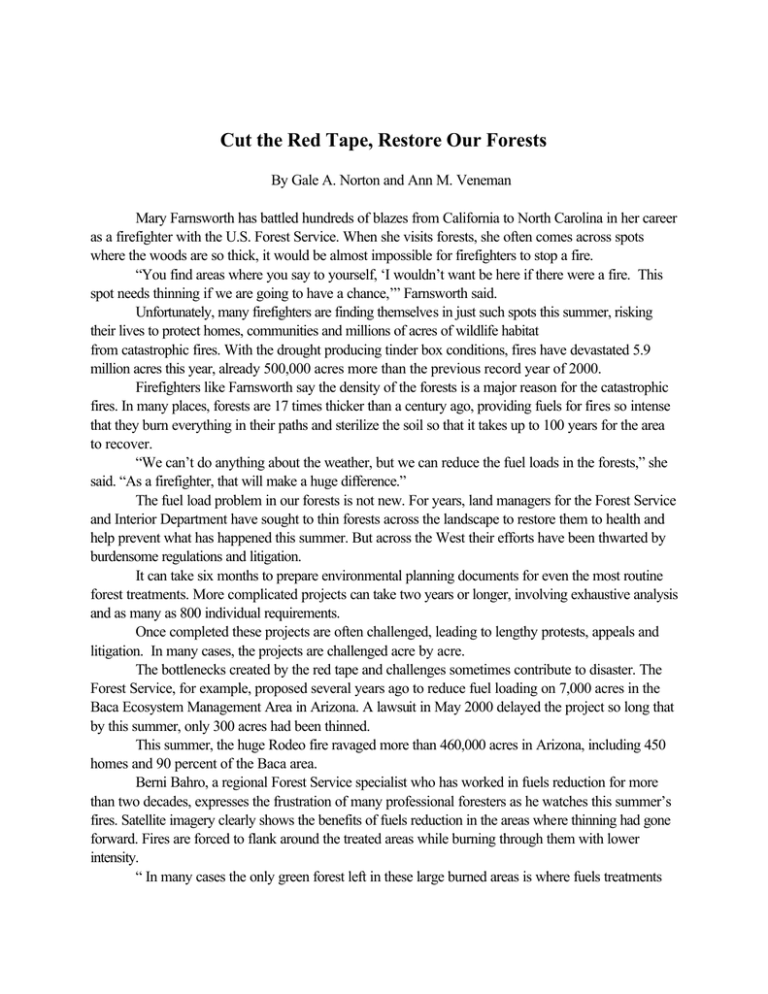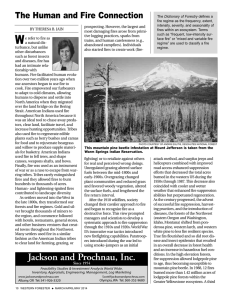Cut the Red Tape, Restore Our Forests
advertisement

Cut the Red Tape, Restore Our Forests By Gale A. Norton and Ann M. Veneman Mary Farnsworth has battled hundreds of blazes from California to North Carolina in her career as a firefighter with the U.S. Forest Service. When she visits forests, she often comes across spots where the woods are so thick, it would be almost impossible for firefighters to stop a fire. “You find areas where you say to yourself, ‘I wouldn’t want be here if there were a fire. This spot needs thinning if we are going to have a chance,’” Farnsworth said. Unfortunately, many firefighters are finding themselves in just such spots this summer, risking their lives to protect homes, communities and millions of acres of wildlife habitat from catastrophic fires. With the drought producing tinder box conditions, fires have devastated 5.9 million acres this year, already 500,000 acres more than the previous record year of 2000. Firefighters like Farnsworth say the density of the forests is a major reason for the catastrophic fires. In many places, forests are 17 times thicker than a century ago, providing fuels for fires so intense that they burn everything in their paths and sterilize the soil so that it takes up to 100 years for the area to recover. “We can’t do anything about the weather, but we can reduce the fuel loads in the forests,” she said. “As a firefighter, that will make a huge difference.” The fuel load problem in our forests is not new. For years, land managers for the Forest Service and Interior Department have sought to thin forests across the landscape to restore them to health and help prevent what has happened this summer. But across the West their efforts have been thwarted by burdensome regulations and litigation. It can take six months to prepare environmental planning documents for even the most routine forest treatments. More complicated projects can take two years or longer, involving exhaustive analysis and as many as 800 individual requirements. Once completed these projects are often challenged, leading to lengthy protests, appeals and litigation. In many cases, the projects are challenged acre by acre. The bottlenecks created by the red tape and challenges sometimes contribute to disaster. The Forest Service, for example, proposed several years ago to reduce fuel loading on 7,000 acres in the Baca Ecosystem Management Area in Arizona. A lawsuit in May 2000 delayed the project so long that by this summer, only 300 acres had been thinned. This summer, the huge Rodeo fire ravaged more than 460,000 acres in Arizona, including 450 homes and 90 percent of the Baca area. Berni Bahro, a regional Forest Service specialist who has worked in fuels reduction for more than two decades, expresses the frustration of many professional foresters as he watches this summer’s fires. Satellite imagery clearly shows the benefits of fuels reduction in the areas where thinning had gone forward. Fires are forced to flank around the treated areas while burning through them with lower intensity. “ In many cases the only green forest left in these large burned areas is where fuels treatments had occurred,” Bahro said. “For fuels reduction to be effective, we have to do it across the landscape. Right now, we are being micro-managed to the point where we can’t be effective.” On Thursday, President Bush toured Squires Peak area near Medford, Oregon, where six years of analysis and legal review, 830 pages of documentation, several appeals and two lawsuits left dense forest untreated. When lighting hit the area in July, more than 2,800 acres of forest burned, destroying valuable timber lands and habitat for two endangered species alike. The president announced his Healthy Forests Initiative, directing us to work with Council on Environmental Quality Chairman James Connaughton to improve the regulatory process to ensure more timely decisions, greater efficiency and better results in reducing catastrophic wildfires by restoring forest health. Steps we will take include reducing the number of overlapping environmental reviews by combining project analysis and establishing a process by which different federal agencies can clear projects simultaneously. We also will develop better guidance for land managers in complying with the National Environmental Policy Act, including developing a model environmental assessment for forest health projects. The president also urged Congress to facilitate fuel reduction with legislation that will expedite forest health projects, especially in high priority areas, and allow federal agencies to enter into long-term stewardship contracts with the private sector, nonprofit organizations, and local communities. Contractors would keep wood products in exchange for the service of thinning trees and brush and removing dead wood. Legend has it that Nero fiddled while Rome burned. With more than 190 million acres of federal land currently at high risk of catastrophic fire -- an area twice the size of California -- we can’t afford to fiddle as the West burns. We must take action now to cut the red tape and restore the health of our forests through fuel reduction. President Bush has challenged federal agencies to work with state and local governments to find solutions. We will do so. Congress must follow suit with quick and decisive action. The future of our forests depends on it.




